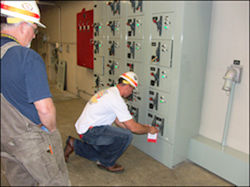Shift Change
How is the continuity of lockout or tagout protection maintained during shift or personnel changes?
Employers must ensure the continuity of employee protection by providing for the orderly transfer of lockout or tagout device protection between off-going and incoming employees. This will help to minimize exposure to hazards from the unexpected energization or start-up of the machine or equipment or the release of stored energy [29 CFR 1910.147(f)(4)].
Shift Change Procedure
If a lockout procedure will extend into the following shift, the employer will usually require the authorized employee who originally placed the lock to remove it. The ongoing authorized employee will then immediately replace the lock and continue the repair or maintenance on that equipment or machine for the following shift.
Working with Contractors
Whenever contractors and other outside servicing personnel perform tasks covered by the Lockout/Tagout standard, they must adhere to all the OSHA standard's requirements. The host employer and the contractor or outside employer must inform each other of the other's respective lockout or tagout procedures.
The host employer and the contractor must understand one another's lockout and tagout procedures. Make sure you review the contractor's energy-control program before the contractor does any on-site work. The host employer's workers must also understand and comply with the contractor's energy-control program.
Note: If you hire a one-person "independent contractor," he or she may claim they do not have to comply with State or Federal OSHA standards. They may be right, if they are not required to participate in a workers' compensation system. However, that does not relieve you, as the general or host employer, from legal liability under the OSH Act. Make sure you require all contractors, no matter what their business status is, to adhere, at a minimum, to OSHA standards. If the contractor puts up a fuss, I personally would not do business with the contractor.
If the sub-contractor is using their own LOTO procedures, the on-site general contractor or host employer must ensure their workers understand and comply with the restrictions and prohibitions of the contractor or outside employer's energy control program.
Be sure to check out OSHA's 1910.147, Appendix A, Typical minimal lockout procedures for examples of lockout/tagout procedures.
Knowledge Check Choose the best answer for the question.
3-10. What is the legal ramification if an independent subcontractor, who claims he or she does not have to comply with State or Federal OSHA regulations, performs servicing or maintenance tasks without using lockout/tagout procedures?
You forgot to answer the question!

